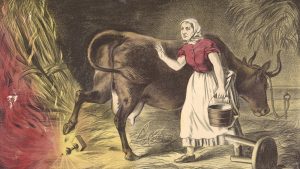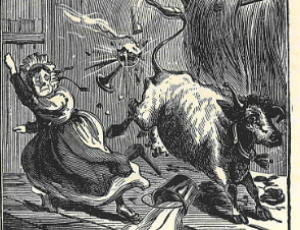“A Hot Time in the Old Town”
Some may remember learning a song when they were younger that went something like this… give or take a few words…
“One dark night, when we were all in bed,
Mrs. O’Leary left a lantern in the shed.
And when the cow kicked it over,
She winked her eye and said,
‘There’ll be a hot time in the old town tonight!’”
Spoofs and Spinoffs

Mrs. O’Leary & her cow – allegedly the cause of the fire
This song, “A Hot Time in the Old Town” was originally written with similar lyrics, but no involvement of a cow in any way. As the song became popular near the end of the 19th century, musicians started to make spoofs and spinoffs of the hit song, which is precisely where Mrs. O’Leary’s cow comes into the picture, or better yet, the song.
Flossie Nash…
Sources say that the lyrics about the Great Chicago Fire (above) were apparently written by Flossie Nash in March of 1898, almost 27 years after the fire itself, which was when the hit song “A Hot Time in the Old Town” (the original) was at its peak popularity (Loerzel 2020).
…proof?
However, there is no evidence proving that Nash is the one that wrote these lyrics as there has been no record of any sheet music of the version of the song about Mrs. O’Leary and her cow. As far as we know, the only way that the song has spread from the time it was “written” is simply by word of mouth, from tradition, from being passed from parent to child and beyond (Loerzel 2020).
Location, known. Source, unknown.
Regardless of who wrote the song, it’s important to know the backstory and the legend that goes along with it. The location where the Great Fire began is known, but the actual source of the fire remains unknown and will likely stay that way for the foreseeable future. There are only suspicions as to how the fire started, and one of them revolves around a cow on the O’Leary’s property, where the fire is known to have begun.
The Cow Legend

Legend has it, on the night of October 8, 1871, one of the cows in the O’Leary’s barn kicked over a lantern that had been lit, knocking it over and causing the fire that destroyed 17,000 structures, killed 300 people, and left 100,000 homeless. Catherine and Patrick O’Leary immediately denied this rumor and claimed that they, and their cows, were innocent and not to blame for this tragedy (History.com, “Chicago Fire of 1871”, Aug. 2018). Although there is a good amount of certainty regarding where the fire began, there is still so much uncertainty regarding how the fire started.
Catherine O’Leary Exonerated
For so many years, the O’Leary’s were overwhelmed with accusations, frustration, and most of all, even guilt. Catherine O’Leary passed away in 1895, but relatives continued working on exonerating her of guilt, which wasn’t successful until 1997, 102 years after her death and 126 years after the fire itself (Wilson 2017). It was then that Chicago’s Committee on Police and Fire officially cleared her of all guilt in connection with the Great Chicago Fire of 1871 that claimed 300 lives and affected the lives of hundreds of thousands more (Wilson 2017).
Other Myths
There are plenty of other ideas, or myths, as to what caused the fire, some of which are:
- Milk thieves
- Drunken neighbors
- Spontaneous combustion
But again, the true cause may never be known.
